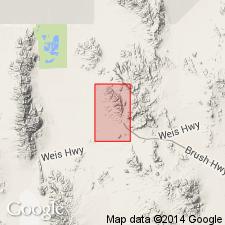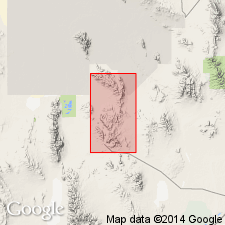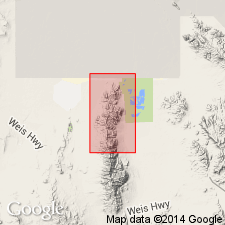
- Usage in publication:
-
- Lost Sheep dolomite*
- Modifications:
-
- Named
- Dominant lithology:
-
- Dolomite
- Chert
- AAPG geologic province:
-
- Great Basin province
Summary:
Named for occurrence at Lost Sheep mine, western side Spors Mountain, Juab Co, UT in the Great Basin province. Type section is in outcrop strip surrounding mine but was measured on northwest side of steep canyon 2,000 ft southwest of Blowout mine in sec 28, T12S, R12W where formation is 149 ft thick and overlies Harrisite dolomite (new) and underlies Thursday dolomite (new). Other good sections found at 1,550 ft and 4,000 ft southwest of Oversight mine. Divided into a gray member which is made up of 3 light- to medium-gray and one black dolomite beds making up the lower two-thirds of the formation, and a cherty member which is a gray, medium-grained faintly mottled dolomite consisting of 15-60 percent chert. Gray member ranges from 149 to 159 ft thick. Cherty member ranges from 66 to 92 ft thick. Horn corals, brachiopod, and gastropods found. Assigned a Middle Silurian age. Geologic map. Stratigraphic sections.
Source: GNU records (USGS DDS-6; Denver GNULEX).

- Usage in publication:
-
- Lost Sheep dolomite*
- Modifications:
-
- Overview
- AAPG geologic province:
-
- Great Basin province
Summary:
Mapped (geologic map) on Spor Mountain, Eagle Rock Ridge, and in Fandangle Canyon, near peak 6,830, and west of Castle Mountain in the Dugway Range, UT in the Great Basin province. Section 272 ft thick on west side of Dugway Range, 1.9 mi west-southwest of Castle Mountain measured. At that locality Lost Sheep overlies Harrisite dolomite (a black, massive, sandy-textured dolomite), underlies Thursday dolomite (a white, medium-grained, sandy-textured dolomite), and consists of white, dark-gray to black, fine-, medium- to coarse-grained dolomite. Ranges from 215 to 270 ft thick. Top part has pink to white chert layers. Is sparsely fossiliferous. HALYSITES found in upper member. Other fossils noted (crinoid stems, smooth pentameroid brachiopod, ribbed brachiopod, gastropod). Middle Silurian age assignment based on Silurian age of brachiopod and on stratigraphic position.
Source: GNU records (USGS DDS-6; Denver GNULEX).

- Usage in publication:
-
- Lost Sheep Member*
- Modifications:
-
- Revised
- AAPG geologic province:
-
- Great Basin province
Summary:
Reduced in rank and assigned as third from base of four members of Laketown Dolomite in Fish Springs Range, Juab Co, UT, Great Basin province. Overlies Harrisite Member (rank reduced) and underlies Thursday Member (rank reduced), both of Laketown. Middle Silurian age.
Source: GNU records (USGS DDS-6; Denver GNULEX).
For more information, please contact Nancy Stamm, Geologic Names Committee Secretary.
Asterisk (*) indicates published by U.S. Geological Survey authors.
"No current usage" (†) implies that a name has been abandoned or has fallen into disuse. Former usage and, if known, replacement name given in parentheses ( ).
Slash (/) indicates name conflicts with nomenclatural guidelines (CSN, 1933; ACSN, 1961, 1970; NACSN, 1983, 2005, 2021). May be explained within brackets ([ ]).

